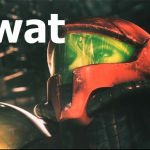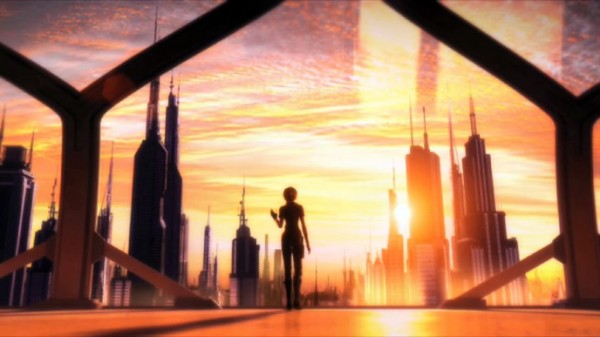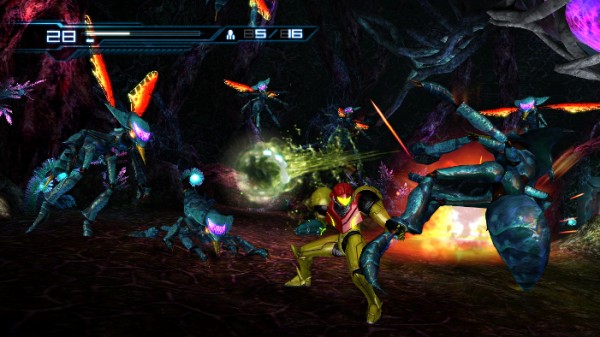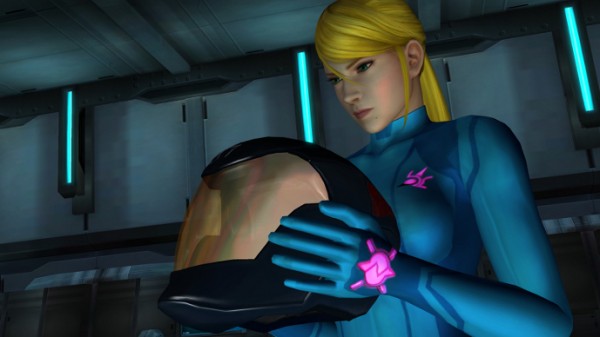
Metroid: Other M is a Great Game
Preface
Besides Metroid: Other M, I have never played a Metroid game before. I know, I know. I plan on getting the Prime games at some point, and then Super Metroid on the VC. Since all my knowledge of Samus Aran before this game came exclusively from Super Smash Bros., I feel like I went into Other M fresh and unbiased. My reactions, as you will see, varied from most other Nintendo fans’ out there.
The Set-up
Metroid: Other M is the 2010 installment of Nintendo’s famed Metroid series. It was published by Nintendo and developed by Team Ninja. Yeah, that Team Ninja. The Dead or Alive Japanese-teenagers-groping-each-other-in-bikinis people. Hey, everyone needs a hobby.
Other M is an action title that tells the story of Samus Aran, Nintendo’s third most famous silent game protagonist. This time, we are treated to a more narrative-heavy experience, as opposed to atmospheric shooters or action/platformers. Long cut scenes that are directed with strong lighting and highly realistic visual detail fill the gaps between stretches of game play wherein you explore an old, abandoned space facility to uncover the secrets hidden within its depths.
I was seriously excited to pre-order this game. A thriller mystery story starring of one gaming’s most famous femme fatales? An emotionally-gripping look at Samus Aran’s tortured past? Amazing visuals that rival Xbox 360 or PS3 titles? Plus a cool art book! Gotta love them art books.
How someone could call this the worst game of 2010 is beyond me. Keep in mind that 2010 saw Command & Conquer 4, 007: Blood Stone, Sonic Free Riders, and SceneIt: Twilight
The Execution
In Metroid: Other M, Samus Aran recovers from the final battle of Super Metroid. Samus defeats Mother Brain with the help of a shockingly helpful Metroid baby. Months later, Samus is back at the bounty-hunting game when she receives an unusual distress call. It’s called the Baby’s Cry. It is coming from an old, derelict Galactic Federation facility named the Bottle Ship. Samus goes to investigate.
Baby’s Cry? Bottle Ship? The weird thing that this game does from the very beginning is paint Samus is a very new and head-scratching light. She continues to mourn the death of “the baby” Metroid like it was significant to her. Yeah, it saved her life, sure. But Samus never shuts up about it. The game goes to great lengths to emphasize the emotional bond that Samus had to the baby. And judging by all the language used, it’s meant to be a maternal bond.
The first portion of the game wants to nail down into the gamer’s head that Samus felt like the Metroid baby was her own child. Because parental bonds are emotional, right? I guess. I’m no parent, but I guess that makes sense.
Samus heads inside the Bottle Ship in her iconic, orange suit. She soon meets a troop of Galactic Federation soldiers lead by one Adam Malkovich, the very man who took Samus under his wing when she was young. This Federation troop is also investigating the Baby’s Cry, so Samus elects to join Adam. The game shows some cut scenes of Samus making her way into the Federation’s cadet training. As you would expect, she was a lone wolf personality. She resented that her male peers treat her differently because she was an attractive blond woman. Her teenage angst built up and she quit. She left Adam’s training to make her own way in bounty hunting. I should mention how beautifully-directed all these cut scenes are.
Samus works her way further into the Bottle Ship. To do this, the player must explore, find new locations and items, and defeat the stray alien beasts infesting the ship. The combat is simple. Press 1 to shoot and hold it to charge. Press 2 to jump. There’s an auto-aim feature because you do not have control over the camera. Defeating these monsters is like No More Heroes with a Mega Buster: it’s brutal and it never gets old. The platforming involved in exploring the levels of the Bottle Ship is well done.
The Bottle Ship has many types of environments to suit the many experiments that happened within. From tundra landscapes to deserts to volcanoes, Samus will have plenty of locations to explore. The enemies are varied, and many require special methods to destroy. Items like missile upgrades and health upgrades are hidden cleverly throughout the game. Finding every single one is a true challenge for those who love exploration.
Other M created a melee kill system for Samus. Get ’em, girl!
As the game goes on, we learn more about the Bottle Ship facility and what it was used for. Then Adam’s Federation soldiers begin to disappear. It’s not long before Samus has a full mystery on her hands, and playing through the game as she unravels this mission’s potential sabotage is absolutely riveting. In the later chapters, I was no joke on the edge of my couch with anticipation. These writers should be commended for the intrigue that they were able to create just within Samus’ head. They should not be commended for everything, though.
Aside from the excellent boss battles, engaging game play, and fantastic cut scenes, there are some aspects of the game that Other M doesn’t get right. And they’re not small details, either.
What Went Wrong
Other M is a bastion of smart game design and cinematic direction. What I hate about overly-detailed Western AAA FPS cut scenes is done perfectly in Other M. Graphics here not only look pretty, but offer a wonderful atmosphere that makes the player feel alone in an enormous, enigmatic space ship. Again, gorgeous and hyper-detailed visuals are something that many developers tend to emphasize instead of interesting game play. But Other M has both!
So what does Other M do wrong? In order to explain this, we have to think about what this game is trying to accomplish in the first place. Other M is a character study. Nintendo and Team Ninja want to explore the mind or Samus Aran in a gritty and psychological way. They want to explore her past and how that formed who she is at present. This story is meant to be deep. Meaningful. Slowly-paced. Artsy. Exactly the kind of thoughtful, serious story-telling that the game industry just doesn’t see often.
The fact is that the writing failed in its exploration of Samus Aran’s psychology. The most important part of this game’s artistic approach (her brain) was handled so poorly that it’s impossible to disguise.
As I mentioned, Samus Aran spends much of this game mourning the loss of the Metroid baby. We are never given a reason why she felt a maternal bond to it. It’s just a Metroid. There are a million of them! And they’re horrible, parasitic beasts! Why attach so much emotion onto one single creature that she met for about a minute? It just doesn’t make sense.
In the cut scenes that follow, we see more of Samus and hear her inner monologue. In these speeches, her voice is soft and weak. She sounds like she wants to give up on this whole Space Pirates business. We see a determined, brave young woman animated in a gorgeous, futuristic city, but the voice we hear sounds like someone who wants to roll into a blanket and eat a jar of Nutella. There’s a disconnect here. The Samus that we see in the Bottle Ship blasting aliens to pieces is confident. She’s stolid. But the Samus in the cinematic sequences is a frightened little girl who doesn’t belong in a military operation.
What the heck is this character? Mixed signals much? Other M features some very inconsistent characterization for our heroine. In one scene, she seems to venture fearlessly into the unknown with only her blaster and her wit. The next, she cowering in fear at the mere sight of Ridley (in fact, the game literally shows Samus as a little girl in this battle intro). Who is Samus?
A noble attempt at wonderful character-centered game narrative crumbles before our eyes.
If this were just any protagonist, this wouldn’t be much of a problem. But this is SAMUS ARAN. This is one of the industry’s most famous females ever! And most importantly, this woman is the main focus of this character study, and this game! Nobody wants to watch a weak, childlike Samus Aran shiver in fear in front of an alien! Gamers want to rip out Ridley’s skull Mortal Kombat style. This previously heroic character in gaming culture has now been reduced to a blubbering, emotionally-incontinent teenage girl. And nobody wants that.
If you want us to respect Samus Aran, we need to see her strength. This is done through what is called a character arc. At first, you show Samus weak and afraid. Show us that Samus feels intimidated by the forces around her. Let us know how small Samus feels in the face of Ridley. Then, through a series of motivational cut scenes, player-controlled battles, and some nice voice acting, show us the Samus Aran that we know. Show us a woman over-coming her fear and kicking ass. Let us see in action a person opposing her antagonist to mature emotionally and psychologically. We want to cheer when our hero pulls through. Make a hero out of Samus!
Nobody cares when someone is weak and afraid. It makes for poor story-telling and even worse game design. We might be sympathetic, but we certainly wouldn’t want to play as that person.
The Verdict
There’s a lot going on in Metroid: Other M. There’s a lot to take in visually. There’s a lot to explore and find in the dank depths of the Bottle Ship, and lots of puzzles to solve. There are aliens to destroy. There’s a dark, dubious mystery to solve that spans light years. There’s some great atmosphere to get lost in. These game elements are the most important aspects of an action game. And this game executes them with flying colors.
Where this game goes wrong is in the psychology of Samus Aran, one of the selling points and the main source of audience interest in the plot. Her personality is all over the road, and seeing as her mind is so central to why you’re playing this game, this is no small mistake. Weakening your protagonist is no way to get the player invested.
Does Samus Aran’s poor characterization ruin the game? No. Not at all. People give this game a bad rap because of that, which is very unfair. What they are missing is that the essential elements of video games (game play, visual style, audio, and audience immersion) are all present in full swing. It’s a great game that pulls you into its world, despite its one serious flaw.
4/5
Don’t Believe Everything You Read
Oh boy. I bet a lot of people out there might have a lot to say about this game. Open the bomb bay doors, reload your missiles by holding the Wii remote vertically, and enter our forums for more discussion!
Categories: News



0 Comments
This post has been left all alone with no comments. Don't leave it lonesome - give it some company with a comment.